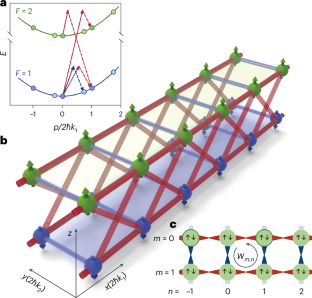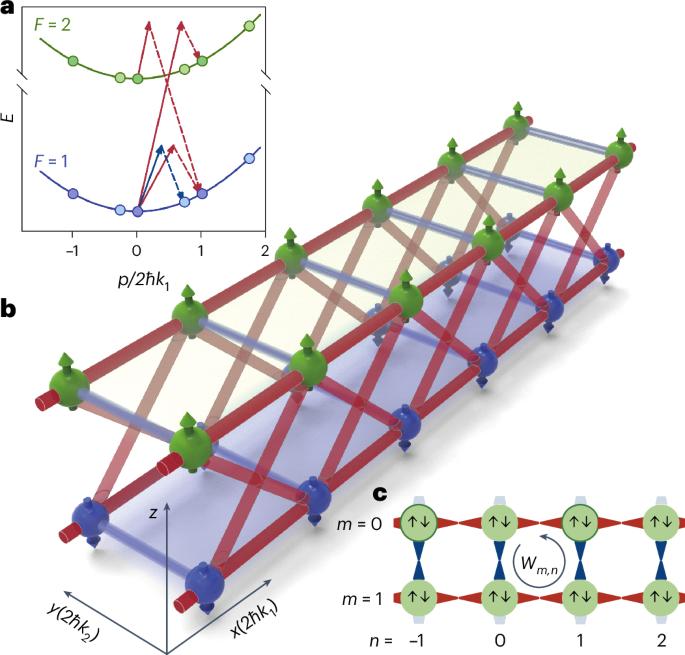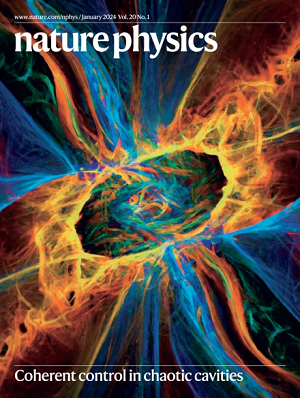Chiral dynamics of ultracold atoms under a tunable SU(2) synthetic gauge field
IF 17.6
1区 物理与天体物理
Q1 PHYSICS, MULTIDISCIPLINARY
引用次数: 0
Abstract
Surface currents arise in superconductors under magnetic fields and are a key signature of the Meissner effect. Similarly, chiral dynamics have been observed in quantum simulators under synthetic Abelian gauge fields. These simulators offer flexible control, enabling the engineering of non-Abelian gauge fields, although their influence on chiral dynamics remains unclear. Here, we implement a synthetic SU(2) gauge field in a spinful one-dimensional ladder and investigate the resulting chiral dynamics by developing a Raman momentum-lattice technique. We confirm the non-Abelian nature of the synthetic potential by observing the non-Abelian Aharonov–Bohm effect on a single plaquette. Furthermore, we find that the chiral current along the two legs of the ladder is spin dependent and highly tunable through the gauge potential parameters. We experimentally map out different dynamic regimes of the chiral current, revealing the competition between overlaying flux ladders with different spin compositions. Our experiment demonstrates the impact of non-Abelian gauge fields on chiral dynamics and offers a viable approach to implementing exotic synthetic gauge fields using Raman momentum lattices. The implementation of synthetic Abelian gauge fields in quantum simulators can result in chiral edge currents. The impact of non-Abelian gauge fields on chiral dynamics of ultracold atoms is now explored using a momentum-space lattice technique.


可调 SU(2) 合成规规场下超冷原子的手性动力学
超导体在磁场作用下会产生表面电流,这是迈斯纳效应的一个重要特征。同样,在合成阿贝尔规量场下的量子模拟器中也观测到了手性动力学。这些模拟器具有灵活的控制能力,可以实现非阿贝尔规量场的工程设计,但它们对手性动力学的影响仍不清楚。在这里,我们在自旋一维梯子中实现了一个合成的 SU(2) 轨则场,并通过开发拉曼动量晶格技术研究了由此产生的手性动力学。我们通过观察单个格子上的非阿贝尔阿哈诺夫-玻姆效应,证实了合成势的非阿贝尔性质。此外,我们还发现沿着梯子两条腿的手性电流与自旋有关,并可通过规势参数进行高度调谐。我们通过实验绘制了手性电流的不同动态范围,揭示了不同自旋成分的叠加通量梯之间的竞争。我们的实验证明了非阿贝尔规势场对手性动力学的影响,并提供了一种利用拉曼动量晶格实现奇异合成规势场的可行方法。
本文章由计算机程序翻译,如有差异,请以英文原文为准。
求助全文
约1分钟内获得全文
求助全文
来源期刊

Nature Physics
物理-物理:综合
CiteScore
30.40
自引率
2.00%
发文量
349
审稿时长
4-8 weeks
期刊介绍:
Nature Physics is dedicated to publishing top-tier original research in physics with a fair and rigorous review process. It provides high visibility and access to a broad readership, maintaining high standards in copy editing and production, ensuring rapid publication, and maintaining independence from academic societies and other vested interests.
The journal presents two main research paper formats: Letters and Articles. Alongside primary research, Nature Physics serves as a central source for valuable information within the physics community through Review Articles, News & Views, Research Highlights covering crucial developments across the physics literature, Commentaries, Book Reviews, and Correspondence.
 求助内容:
求助内容: 应助结果提醒方式:
应助结果提醒方式:


